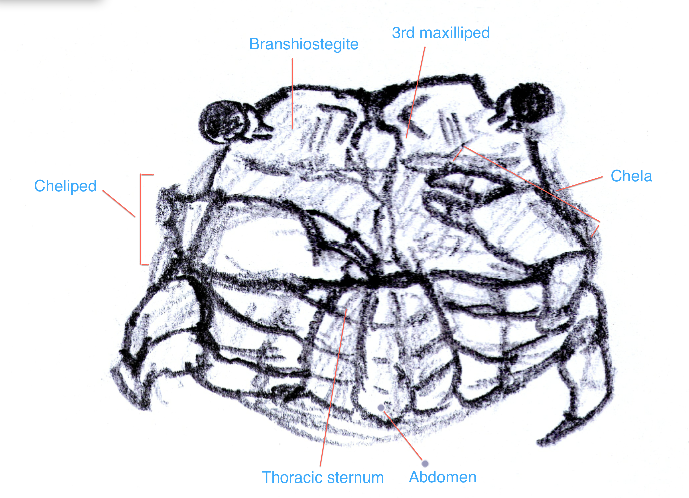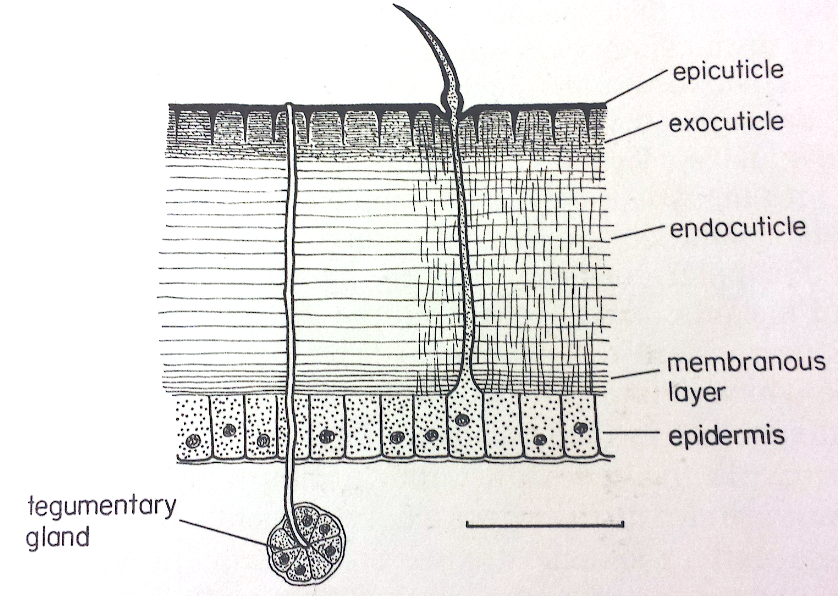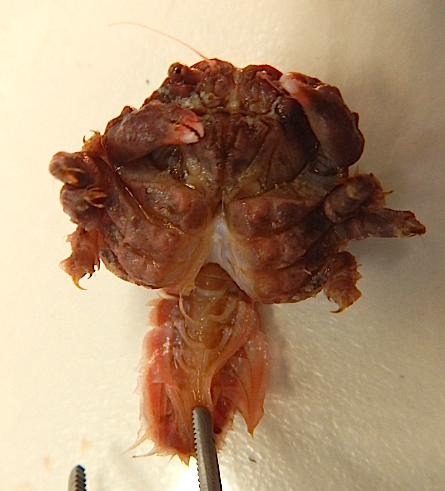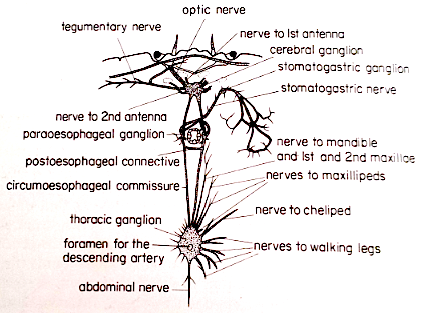Introduction
Morphology
Ecology
Life History & Behaviour
Life Cycle
Behaviour
Symbiosis
Anatomy & Physiology
Dromiidae vs. Carpiliidae
Evolution
Classification
Biogeographic Distribution
Conservation & Threat
References & Links |

Body Plan & Appendages
The general anatomy of the body plan and appendages of the Stimdromia lateralis are shown on the diagrams below.
Dorsal view of Stimdromia lateralis.

Ventral view of Stimdromia lateralis.

4th Pereiopod of Stimdromia lateralis under microscope.
Exoskeleton
The exoskeleton of the sponge crab is similar to those in other Brachyurans. This structure provides protection for the crab as it is covered by tough heavily calcified cuticles.
The exoskeleton is made out of four layers: Epicuticle, Exocuticle, Endocuticle and Membranous layer (as shown below).

Transverse Section of the Exoskeleton of Brachyura Cuticle (Warner, 1977)
Gut: Ectodermal foregut and hind-gut that are lined with cuticle, endodermal mid-gut that lacks cuticle.
Mouth: Gland cells supplied mouth opening are situated between and behind the mandibles.
Oesophagus: Short muscular tube that is also invested with gland cells.
Stomach: There are two main regions of the stomach, the cardiac stomach, and the pyloric stomach.
With the special feature of gastric mill on the posterior end of the cardiac stomach, the cardiac stomach is mainly used for chewing and grinding, since the mandibles only cut and crush food when food is ingested by the mandibles, but not chewing (Warner, 1977).
Once food is processed into smaller pieces in the cardiac stomach, they enter the pyloric region of the stomach which is responsible for filtering and sorting of food particles. Finely ciliated lining allows only small particles and liquid to pass through, the rest of the indigestible matters and coarser materials bypass the mid-gut and are then excreted from the anus at the end of the hind-gut (Warner, 1977).
Excretory System
The excretory organs of crustaceans are called the green glands, paired ducts structure that is situated at the base of the 2nd antennae (Ruppert et al., 2004).
There are four functional parts: End Sac, Labyrinth, Bladder and the Ureter. The end sac and the labyrinth are situated closely and together they form a green sponge mass behind the orbits. These are the sites where blood ultrafiltration and urine modification occur. The bladder is situated over the stomach of the crab, and it is connected to the ureter (Warner, 1977).
The main function of the excretory organs is not to get rid of nitrogenous wastes but to osmoregulate, hence to maintain ion-water balance, since they are ammonotelic, most of the ammonia is lost by diffusion over the gills (Ruppert et al., 2004 & Warner, 1977).

The abdomen and anus of Stimdromia lateralis.
Reproductive System
Gonads are paired organs that sit under the carapace and lie above the hepatopancreas.
Males: Size of gonads are smaller than female. Vasa deferentia which emerge from the testes are sites for sperm storage. Ejaculatory ducts open on the ventral sides of the coxa of the last pair of legs.
Females: Paired genital openings on the sternite of the 6th thoracic segment connecting the spermatheca that lie amongst the basal muscle of the 2nd walking legs. After copulation, the spermatheca are stored with sperms. Short oviducts on either side connect the ovaries to the spemathecae, where eggs pass through for fertilisation.
(Warner, 1977)
Nervous System
The central nervous system (CNS) integrates the behaviour of the sponge crab, the system is consisted of two regions; a pre-oral brain which supplies the eyes and the antennae, and a post-oral ganglionic mass which supplies the rest of the appendages (Warner, 1977).
The two regions are interconnected by a structure called the circum-oesophageal commissures.

The CNS of a brachyuran (Warner, 1977).
|
|